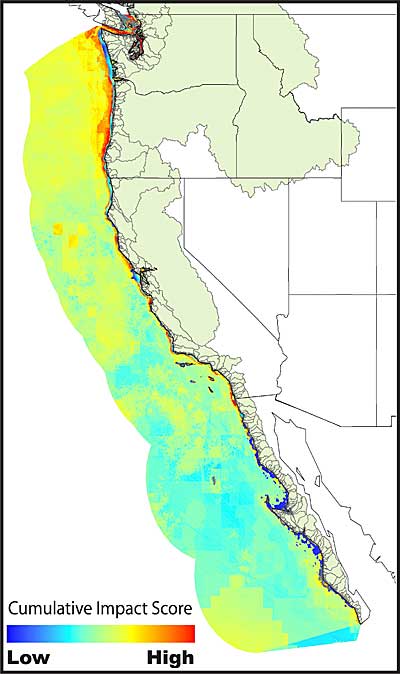Researchers map West Coast ocean threats
June 2009
“Every single spot of the ocean along the West Coast is affected by 10 to 15 different human activities annually.”
—Ben Halpern, marine ecologist at the National Center for Ecological Analysis and Synthesis (NCEAS), University of California at Santa Barbara
|
In a two-year study to document the way humans are affecting the oceans on the West Coast, Halpern and colleagues overlaid data on the location and intensity of 25 human-derived sources of ecological stress, including climate change, commercial and recreational fishing, land-based sources of pollution, and ocean-based commercial activities.
With the information, they produced a composite map of the status of West Coast marine ecosystems. The lead scientists on the study previously conducted a similar analysis on a global scale published last year in Science.

Scientists have developed a map showing West Coast ocean areas most affected by humans. Central coast section enlarged below.
“We found two remarkable and unexpected results in this research,” said Halpern. “Ocean management needs to move beyond single-sector management and towards comprehensive ecosystem-based management if it is to be effective at protecting and sustaining ocean health. Also, the global results for this region were highly correlated with the regional results, suggesting that the global results can provide valuable guidance for regional efforts around the world.”
The study results show that hotspots of cumulative impact are in coastal areas near urban centers and heavily polluted watersheds.
The research involved a four-step process.
First, the scientists gathered information to quantify and compare how different human activities affect each marine ecosystem. For example, fertilizer runoff was shown to have a large effect on salt marshes, but a much smaller one on rocky reefs. Then the researchers gathered and processed data on marine ecosystems and human influences. Next they combined data from the first and second steps to determine “human impact scores” for each location along the West Coast. Finally, they compared regional results to global results for the same areas from the previous analysis.
“The study provides critical information for evaluating where certain activities can continue with little effect on the oceans and where other activities might need to be stopped or moved to less sensitive areas,” said Phillip Taylor, section head in the National Science Foundation Division of Ocean Sciences.
“The results are a wake-up call,” said Halpern. “We are significantly affecting the oceans.”
< back to all issues

